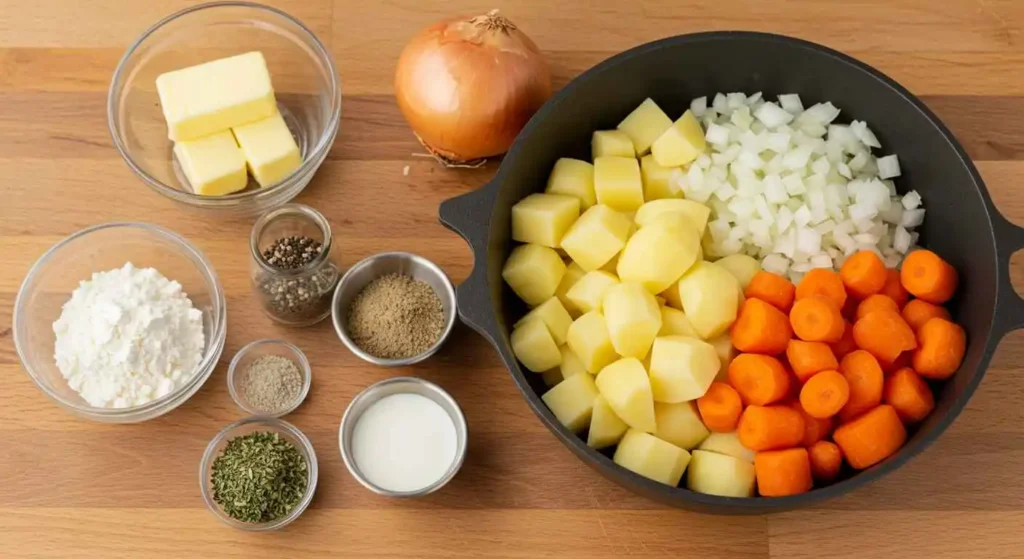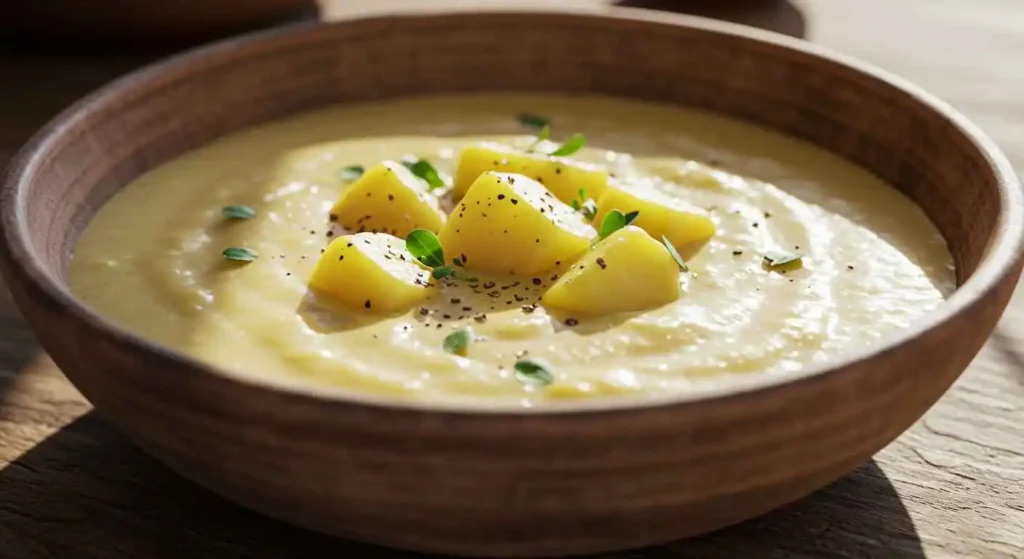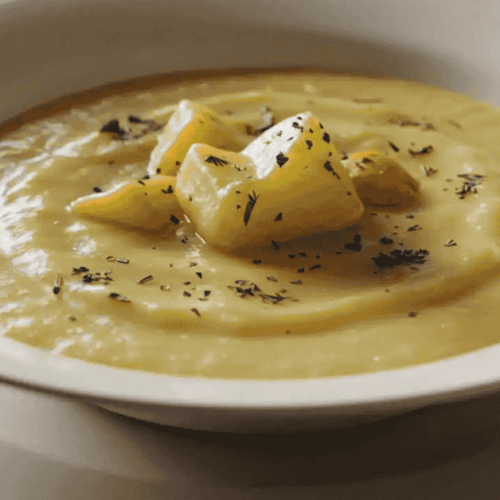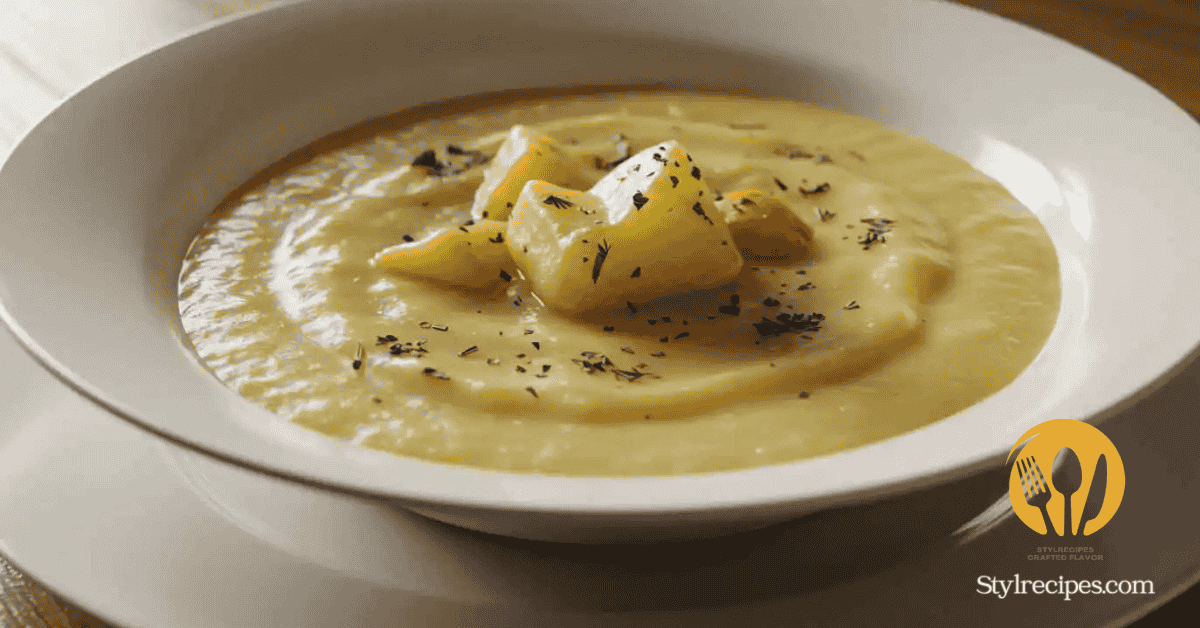Introduction: A Bowl of Comfort
There’s something deeply comforting about a steaming bowl of homemade potato soup. The moment that velvety spoonful touches your lips, worries seem to melt away like butter on hot bread. Growing up in a small midwestern town, potato soup wasn’t just dinner—it was our family’s remedy for everything from winter blues to celebrating fall harvests. The rich, creamy texture paired with the earthy flavor of potatoes creates more than just a meal—it creates memories that linger long after the dishes are cleared.
Whether you’re a cooking novice or a seasoned chef looking to perfect your recipe, this comprehensive guide will walk you through everything you need to know about how to make a hearty potato soup that brings warmth to both body and soul. By the time you’ve finished reading, you’ll have all the knowledge necessary to create a pot of potato soup that rivals any restaurant offering—all from the comfort of your own kitchen.
Table of Contents
The Magic of Potato Soup: Why It’s a Timeless Classic
Potato soup stands as a cornerstone in culinary traditions worldwide, and for good reason. This humble dish traces its roots back centuries, appearing in European cookbooks as early as the 1700s. Peasants and nobility alike embraced the potato’s versatility and nourishing qualities, transforming this once-suspicious “apple of the earth” into comfort food royalty.
Beyond its rich heritage, potato soup offers remarkable nutritional benefits. Potatoes themselves provide substantial vitamin C, potassium, and fiber, particularly when cooked with skins intact. When combined with other vegetables and broth, the soup transforms into a nutrient-dense meal that satisfies hunger while providing essential vitamins and minerals.
What truly distinguishes potato soup from other culinary offerings is its chameleon-like adaptability. The basic recipe serves as a blank canvas, readily adjusting to accommodate various dietary preferences. Dairy-free? Substitute cream with coconut milk. Vegetarian? Swap chicken broth for vegetable stock. Seeking extra protein? Add bacon, ham, or even plant-based alternatives.
Perhaps most appealing in today’s economy is potato soup’s remarkable cost-effectiveness. Few dishes deliver such satisfying results with such budget-friendly ingredients. A family of four can enjoy hearty bowls of homemade potato soup for less than the cost of a single restaurant appetizer.
Essential Ingredients for the Perfect Potato Soup
Primary Ingredients
| Ingredient | Recommended Amount | Notes |
|---|---|---|
| Potatoes | 2 pounds (about 6 medium) | Yukon Gold or Russet work best |
| Onions | 1 large | Yellow or white onion |
| Garlic | 3-4 cloves | Freshly minced for best flavor |
| Chicken/Vegetable Broth | 4 cups | Low-sodium allows better seasoning control |
| Heavy Cream | 1 cup | Can substitute with half-and-half or milk |
| Butter | 4 tablespoons | Unsalted preferred |
| Salt and Pepper | To taste | Freshly ground pepper enhances flavor |
The foundation of exceptional potato soup begins with selecting the right potatoes. Yukon Golds offer the perfect balance—enough starch to thicken your soup naturally while maintaining their shape during cooking. Russets create a fluffier texture but break down more readily, while waxy varieties like red potatoes hold their shape superbly for chunkier soups.

Quality broth forms the soul of your soup. While store-bought varieties work perfectly well (especially low-sodium versions that let you control salt levels), homemade stock elevates your soup to extraordinary heights. Consider saving vegetable scraps or chicken bones in the freezer to make fresh stock when time permits.
Optional Add-ins for Flavor Enhancement
- Bacon or ham for smoky depth
- Cheese (sharp cheddar, nutty Gruyère, or aged Parmesan)
- Fresh herbs (bright chives, earthy thyme, aromatic rosemary)
- Leeks instead of or alongside onions for subtle complexity
- Celery and carrots for a traditional mirepoix foundation
While these additions remain optional, they represent opportunities to customize your soup according to personal preference or pantry availability. Even small amounts—just a sprinkle of crisp bacon or a handful of freshly grated cheese—can transform your soup from delightful to unforgettable.
Equipment You’ll Need to Make Potato Soup
Creating magnificent potato soup requires surprisingly little specialized equipment. Gather these kitchen essentials before beginning:
- Large, heavy-bottomed pot or Dutch oven (6-quart capacity ideal)
- Sharp chef’s knife for efficient vegetable preparation
- Potato masher or immersion blender for texture control
- Sturdy cutting board (preferably wood or composite)
- Measuring cups and spoons for precise ingredient proportions
- Wooden spoon for gentle stirring without scratching cookware
While specialized equipment like food processors or stand blenders can streamline certain steps, they remain entirely optional. Generations of home cooks produced exemplary potato soups long before such modern conveniences existed.
Step-by-Step Guide: How to Make Potato Soup
Step 1: Preparing Your Ingredients
The journey toward exceptional potato soup begins with thoughtful ingredient preparation. Select potatoes carefully, considering the texture you desire. For balanced results, Yukon Golds offer ideal middle ground—enough starch to thicken naturally while maintaining structural integrity.
Wash potatoes thoroughly under cool running water, using a vegetable brush to remove soil from crevices. While peeling remains optional, consider leaving peels intact for added nutrition and rustic texture. When peeling proves necessary (particularly with thick-skinned Russets), use a sharp vegetable peeler with minimal pressure to preserve precious potato flesh.
Cut potatoes into uniform pieces—roughly 3/4-inch cubes work perfectly. This consistency ensures even cooking throughout, preventing the frustration of finding both undercooked and mushy pieces in the same spoonful. Place cut potatoes in cool water temporarily if not using immediately to prevent oxidation and discoloration.
Prepare aromatic vegetables with equal care. Dice onions finely for melding seamlessly into the soup’s background, or chop more coarsely for textural variety. Mince garlic just before adding to preserve volatile flavor compounds. When incorporating carrots or celery, aim for pieces slightly smaller than potato cubes to ensure they cook through properly.
Step 2: Building the Flavor Base
Creating remarkable potato soup requires building layers of flavor from the beginning. Start with a cold pot before adding butter or oil—this prevents scorching and allows even melting. Once shimmering, add onions first, cooking over medium heat until translucent but not browned (approximately 5-7 minutes).
Incorporate minced garlic only after onions have softened, cooking just 30-60 seconds until fragrant. This prevents the bitter flavors that develop when garlic burns. When using herbs, add woody varieties like thyme or rosemary early in the cooking process, reserving delicate herbs like chives or parsley for finishing.
For soup with luxurious body, create a proper roux by sprinkling flour over sautéed vegetables. Cook flour mixture for at least two minutes while stirring constantly—this eliminates raw flour taste while developing nutty notes that enhance your soup’s complexity. The flour should take on a blonde color but not brown significantly.
When building layers of flavor, don’t overlook the power of deglazing. After vegetables have developed slight caramelization, add a small splash of white wine, broth, or even water to the hot pan. Scrape vigorously with a wooden spoon to dissolve flavorful browned bits (fond) from the pan’s bottom. These concentrated flavor molecules distribute throughout your soup, adding remarkable depth with minimal effort.
Step 3: Cooking Methods for Potato Soup
Traditional stovetop preparation remains the gold standard for potato soup, allowing precise control throughout the cooking process. After adding broth to your flavor base, bring mixture just to boiling before reducing to gentle simmer. Maintaining this gentle bubble—rather than rolling boil—preserves potato integrity while allowing flavors to meld harmoniously. Expect 15-20 minutes cooking time for properly diced potatoes.
Modern cooking appliances offer convenient alternatives without sacrificing quality. Pressure cookers or Instant Pots dramatically reduce cooking time to approximately 5 minutes at pressure, plus natural release time. This method proves particularly valuable on busy weeknights when time constraints might otherwise lead to takeout meals.
Slow cookers provide another excellent option, particularly for those who prefer preparing ingredients in the morning for ready-made dinner upon returning home. Layer ingredients appropriately (potatoes, vegetables, seasonings, then broth) and cook on low setting for 6-8 hours or high setting for 3-4 hours. Add dairy components during the final 30 minutes to prevent potential separation.
Regardless of cooking method, test potatoes for doneness by inserting a fork or knife—it should penetrate easily without resistance. Remember that potatoes continue cooking slightly from residual heat after removing from heat source, so slight firmness at testing stage often yields perfect final texture.
Step 4: Achieving the Perfect Texture
Potato soup’s textural spectrum ranges from velvety smooth to heartily rustic, with countless variations between these extremes. Your preferred texture remains entirely personal preference—no single “correct” approach exists.
For perfectly smooth soup, an immersion blender offers the most convenient solution. Simply insert directly into the cooking pot and pulse until desired consistency develops. This method eliminates the hazardous transfer of hot liquid to countertop blenders. If using traditional blenders, work in small batches, never filling beyond halfway, and always vent the lid slightly to prevent pressure buildup and potential splashing.
For textural contrast within the same pot, consider blending only portion of your soup. Remove approximately one-third of the solids, purée until smooth, then reincorporate with the remaining chunky mixture. This technique creates a soup with body and substance simultaneously.
Creating creamy texture doesn’t necessarily require excessive dairy. Potatoes themselves contain enough natural starch to develop remarkable creaminess. Reserve some cooking liquid before draining, then use this starch-enriched water to adjust final consistency. This technique proves particularly valuable for those limiting dairy consumption.
Common texture issues have simple solutions. Too thin? Continue simmering uncovered to reduce, or create a slurry with equal parts cornstarch and cold water. Too thick? Add additional broth gradually until desired consistency develops. Grainy texture typically indicates overblending or using excessively starchy potatoes—next time, select waxy varieties or blend more gently.
Step 5: Finishing Touches

The difference between good soup and extraordinary soup often lies in final adjustments. Taste thoughtfully before serving, considering balance across multiple dimensions: saltiness, acidity, richness, and intensity. Season conservatively—you can always add more, but removing excess proves impossible.
Enriching with dairy transforms good potato soup into luxurious experience. For maximum smoothness, temper cold dairy first by gradually adding small amounts of hot soup to the cold cream, whisking constantly. This prevents the temperature shock that causes curdling. Once dairy reaches approximately room temperature, incorporate into the main pot.
Garnishing elevates both presentation and flavor. Consider contrasting colors and textures: vibrant green chives against creamy white soup, crispy bacon bits against smooth background, or sharp cheese melting gently into hot surface. Even minimal garnishes—a swirl of olive oil, sprinkle of paprika, or grinding of black pepper—signal thoughtful preparation.
Allow your finished soup to rest 5-10 minutes before serving. This brief pause allows flavors to meld while cooling to comfortable eating temperature. The patience required during this short wait rewards you with noticeably improved flavor integration.
Pro Tips for Elevating Your Potato Soup
Chef-Approved Techniques
- Save potato cooking water instead of draining completely—this starch-rich liquid provides natural thickening power without additional ingredients
- Roast garlic heads whole before adding to soup—this simple step transforms garlic’s pungent bite into sweet, nutty complexity that permeates your creation
- Use cold butter cubes (rather than melted) stirred in just before serving—these create micro-pockets of richness throughout each spoonful
- Balance finished soup with tiny splash of white wine vinegar or lemon juice—this acidity doesn’t make soup taste sour but rather brightens other flavors, much like salt enhances sweetness
Make-Ahead and Storage Advice
- Cool soup completely before refrigerating—dividing into smaller containers accelerates this process while reducing food safety risks
- Store refrigerated soup in airtight containers for 3-4 days—flavor actually improves during first 24 hours as ingredients continue melding
- Freeze in portion-sized containers for up to three months—leave expansion space at container tops to prevent cracking during freezing
- Reheat gently over medium-low heat rather than high temperature—this prevents scorching while allowing even warming throughout
Soup destined for freezing benefits from slight undercooking of potatoes, as they’ll soften further during reheating. Consider omitting dairy before freezing, then adding fresh cream during reheating for optimal texture and flavor.
Dietary Adaptations: How to Make Potato Soup for Everyone
Creating inclusive dishes needn’t sacrifice flavor or satisfaction. Vegan potato soup achieves remarkable creaminess through plant-based alternatives. Coconut milk provides luxurious body without pronounced coconut flavor in finished soup. Cashew cream—made by blending soaked raw cashews with water until perfectly smooth—offers protein-rich alternative with neutral flavor profile. Nutritional yeast adds cheesy complexity without dairy components.
Gluten-free adaptations require minimal adjustment. Simply replace traditional flour in roux with rice flour, cornstarch, or gluten-free all-purpose blend. Alternatively, purée portion of the cooked potatoes to thicken naturally without any added starch. Always verify broth ingredients, as some commercial varieties contain gluten as stabilizer.
For lower-calorie versions, evaporated milk provides creaminess with significantly less fat than heavy cream. Cauliflower purée blended with broth creates remarkably creamy base without additional calories. Emphasize flavor development through aromatics and herbs rather than added fats—caramelized onions, roasted garlic, and fresh herbs contribute negligible calories while maximizing taste satisfaction.
Regional Variations of Potato Soup
Potato soup’s universal appeal spans cultures worldwide, each tradition contributing unique character through distinctive ingredients and techniques.
German potato soup (Kartoffelsuppe) features robust texture with skin-on potatoes, leeks, and carrots, often incorporating sliced wursts during final cooking stages. Caraway seeds provide characteristic flavor, while generous amounts of fresh parsley brighten the finished presentation.
Irish potato soup emphasizes simplicity with exceptional ingredients. Traditional versions rely heavily on leeks alongside potatoes, creating delicate sweetness throughout. Fresh bay leaves and thyme infuse subtle herbal notes, while finishing with Cashel Blue cheese crumbles adds luxurious tanginess.
French cooking transforms humble potato soup into sophisticated Vichyssoise—a pureed potato-leek creation traditionally served chilled, though equally delightful warm. Heavy cream and chives remain essential components, with some variations incorporating white wine for additional complexity.
American loaded baked potato soup reimagines the beloved side dish in liquid form. This hearty interpretation features generous bacon, sharp cheddar, sour cream, and green onions—essentially capturing loaded baked potato flavors in each spoonful. Some variations incorporate small amounts of ranch seasoning for additional dimension.
Pairing Suggestions for a Complete Meal
Creating complete dining experiences requires thoughtful accompaniments alongside your magnificent potato soup.
Complementary bread options enhance satisfaction without overwhelming the soup itself. Crusty sourdough offers perfect textural contrast, while soft dinner rolls provide ideal vehicles for soaking up every last drop. Cheese-topped garlic bread adds indulgence, while simple saltine crackers provide unpretentious crunch.
Salad pairings balance the meal’s richness while contributing contrasting flavors. Consider peppery arugula with lemon vinaigrette, bright coleslaw with apple cider dressing, or classic Caesar with homemade croutons. The key principle: select salads with sufficient acidity to cut through soup’s richness rather than mirroring its creamy qualities.
Beverage selections similarly benefit from thoughtful pairing. For wine enthusiasts, unoaked Chardonnay or crisp Pinot Grigio complements cream-based variations beautifully, while earthy Beaujolais or light Pinot Noir partners wonderfully with heartier versions. Beer drinkers might select Belgian witbier, German hefeweizen, or American amber ale—all offering complementary rather than competing flavors.
Complete your meal with appropriately light dessert. Fresh berries with minimal accompaniment, lemon sorbet, or delicate shortbread cookies provide sweet conclusion without overwhelming already-satisfied diners.
Troubleshooting Common Potato Soup Problems
| Problem | Possible Cause | Solution |
|---|---|---|
| Grainy texture | Overcooked or incorrect potatoes | Use waxy potatoes; don’t overcook |
| Too thin | Insufficient starch or thickener | Add a cornstarch slurry or purée some soup |
| Too thick | Too much potato or flour | Add more broth gradually |
| Bland flavor | Insufficient seasoning | Add salt, herbs, or acid like lemon juice |
| Curdled cream | Added cold cream to boiling soup | Temper cream or use room temperature dairy |
Even experienced cooks occasionally encounter challenges when preparing potato soup. Understanding common issues and their solutions ensures consistent success despite variables beyond your control.
Grainy texture typically results from potato selection or cooking method. Floury varieties like Idaho russets break down more readily than waxy types. When using russets, monitor cooking time carefully—they transform from perfectly tender to disintegrated quickly. For immediate repair, try vigorously whisking soup or blending briefly to redistribute starch particles.
Consistency problems have straightforward solutions. For overly thin soup, create slurry using one tablespoon cornstarch mixed with equal amount cold water, then stir into simmering soup. Alternatively, remove portion of soup, blend until smooth, then reincorporate. For excessive thickness, add broth gradually until desired consistency develops, remembering that soup thickens slightly upon cooling.
Flavor imbalance frequently indicates insufficient seasoning layering during cooking. Remember that potatoes absorb substantial salt, often requiring more seasoning than expected. Beyond salt, consider acid balance—a few drops of white wine vinegar, lemon juice, or even pickle brine can dramatically brighten flavors without imparting identifiable sourness.
Curdled dairy results from temperature shock when cold cream meets boiling liquid. Prevent by removing soup from heat briefly before adding dairy, or by tempering cream (gradually adding small amounts of hot soup to cold cream while whisking constantly). If curdling occurs despite precautions, vigorous blending often repairs the situation by redistributing fat molecules.
Conclusion
Learning how to make potato soup from scratch is more than just following a recipe—it’s about understanding the ingredients, techniques, and flavors that create a truly exceptional dish. With the tips and methods outlined in this guide, you’re now equipped to create potato soup that rivals any restaurant version.
Remember, the best potato soup comes from a place of patience and love for the process. So take your time, experiment with variations that speak to your taste preferences, and enjoy the journey of creating a comforting classic that will bring warmth to your table for years to come.
The beauty of mastering potato soup lies in its infinite adaptability. Once you’ve internalized the fundamental principles, the recipe becomes yours to customize according to season, mood, and available ingredients. Perhaps you’ll develop your own signature version—the one friends request specifically or family members reminisce about years later.
Why not put your new knowledge into practice today? Gather your ingredients, set aside an unhurried hour, and create something truly nourishing for yourself and those fortunate enough to share your table. Your perfect bowl of potato soup awaits—and with it, the satisfaction that comes from transforming humble ingredients into culinary magic through your own two hands.
FAQ: Common Questions About How to Make Potato Soup
What are the best potatoes to use when making potato soup?
Yukon Gold potatoes offer the perfect balance of starchiness and waxy texture for potato soup. Their buttery flavor and medium starch content create ideal creaminess while maintaining enough structure for satisfying texture. Russets work wonderfully for a fluffier soup with velvety consistency, while red potatoes hold their shape superbly if you prefer a chunkier soup with distinct potato pieces throughout.
How do I make potato soup thicker without adding more cream?
To thicken potato soup without additional cream, you have several excellent options. Mash some potatoes directly against the pot’s side using the back of your spoon—these starchy pieces naturally thicken surrounding liquid. Alternatively, remove one cup of soup, blend until completely smooth, then stir back into the main pot. For emergency thickening, whisk one tablespoon cornstarch with equal parts cold water, then stir this slurry into simmering soup. For preventative thickening, create proper roux with butter and flour before adding liquid ingredients.
Can I make potato soup ahead of time for a dinner party?
Absolutely! Potato soup actually improves with time as flavors meld and develop complexity. Make it up to two days ahead, refrigerate promptly in shallow containers for quick cooling, and reheat gently over medium-low heat, stirring occasionally to prevent scorching. Add fresh herbs just before serving for brightness, and consider a splash of additional cream to refresh the texture. If the soup thickens excessively during storage, gradually incorporate small amounts of broth until desired consistency returns.
How many days can homemade potato soup stay fresh in the fridge?
Properly stored in airtight containers, homemade potato soup remains food-safe and delicious for 3-4 days in the refrigerator. Ensure rapid cooling by dividing large batches into smaller portions before refrigerating. When reheating, bring soup to steaming temperature throughout (165°F/74°C) to ensure food safety. For longer storage, freezing provides excellent results—though texture may change slightly upon thawing, particularly with dairy-heavy versions.
What’s the secret to making restaurant-quality potato soup at home?
The secret to restaurant-quality potato soup lies in building layers of flavor throughout the cooking process. Begin with proper aromatics base (onions, garlic, perhaps celery and carrots) cooked slowly until genuinely fragrant. Use quality stock rather than water as primary liquid. Season thoughtfully at every stage rather than only at the end. Incorporate multiple textures through blending techniques. Finish with “secret” professional touches: tiny splash of acid (lemon juice or white wine vinegar), fresh herbs added just before serving, and small amount of cold butter cubes stirred in at the very end for silky mouthfeel and rich flavor.
Is it possible to freeze potato soup successfully?
While potato soup can indeed be frozen, success depends on preparation and expectations. For best frozen results, slightly undercook potatoes initially (they’ll soften further during reheating) and consider reducing or omitting dairy before freezing. Freeze in portion-sized containers with expansion space, and use within three months for optimal quality. When reheating frozen soup, thaw overnight in refrigerator if possible, then warm gently over medium-low heat, stirring frequently. Add fresh cream and adjustment seasonings after reheating to refresh flavors and restore creamy texture.
How can I make my potato soup recipe healthier without sacrificing flavor?
Creating healthier potato soup without sacrificing flavor requires strategic substitutions and additions. Replace heavy cream with evaporated milk, Greek yogurt, or puréed white beans for creaminess with reduced fat. Increase flavor intensity through roasted garlic, caramelized onions, and herb infusions rather than additional butter or cream. Leave potato skins intact for added fiber, nutrients, and textural interest. Incorporate additional vegetables like cauliflower, celery, or carrots to boost nutritional value while maintaining satisfying texture. Use homemade stock without added sodium, allowing you to control salt levels precisely while maximizing flavor depth.

How to Make Potato Soup: Ultimate Guide with Pro Tips
Ingredients
- 4 large russet potatoes peeled & diced
- 1 small onion finely chopped
- 2 cloves garlic minced
- 4 cups chicken or vegetable broth
- 1 cup heavy cream or milk for a lighter version
- 2 tbsp butter
- 1/2 cup shredded cheddar cheese optional
- 1/2 tsp salt adjust to taste
- 1/4 tsp black pepper
- 1/2 tsp smoked paprika for depth of flavor
- 2 tbsp fresh chives chopped, for garnish
- 4 strips crispy bacon crumbled, optional
Instructions
- Sauté Aromatics – In a large pot, melt butter over medium heat. Add onions and garlic, sauté until fragrant.
- Cook Potatoes – Add diced potatoes and broth. Simmer for 15-20 minutes until potatoes are soft.
- Blend for Creaminess – Use an immersion blender to puree some or all of the soup for a smooth, creamy texture.
- Add Dairy & Seasoning – Stir in heavy cream, salt, pepper, and smoked paprika. Let simmer for 5 more minutes.
- Garnish & Serve – Ladle into bowls, top with cheddar cheese, crispy bacon, and fresh chives. Enjoy
Notes
- For extra creaminess, replace half the potatoes with Yukon Gold.
- Use bacon grease instead of butter for a smoky depth of flavor.
- Blend only half the soup if you prefer a chunky texture.
- Make it vegetarian by swapping chicken broth for vegetable broth.
- Storage: Keep leftovers in an airtight container for up to 4 days. Reheat on low heat, adding broth if needed.

